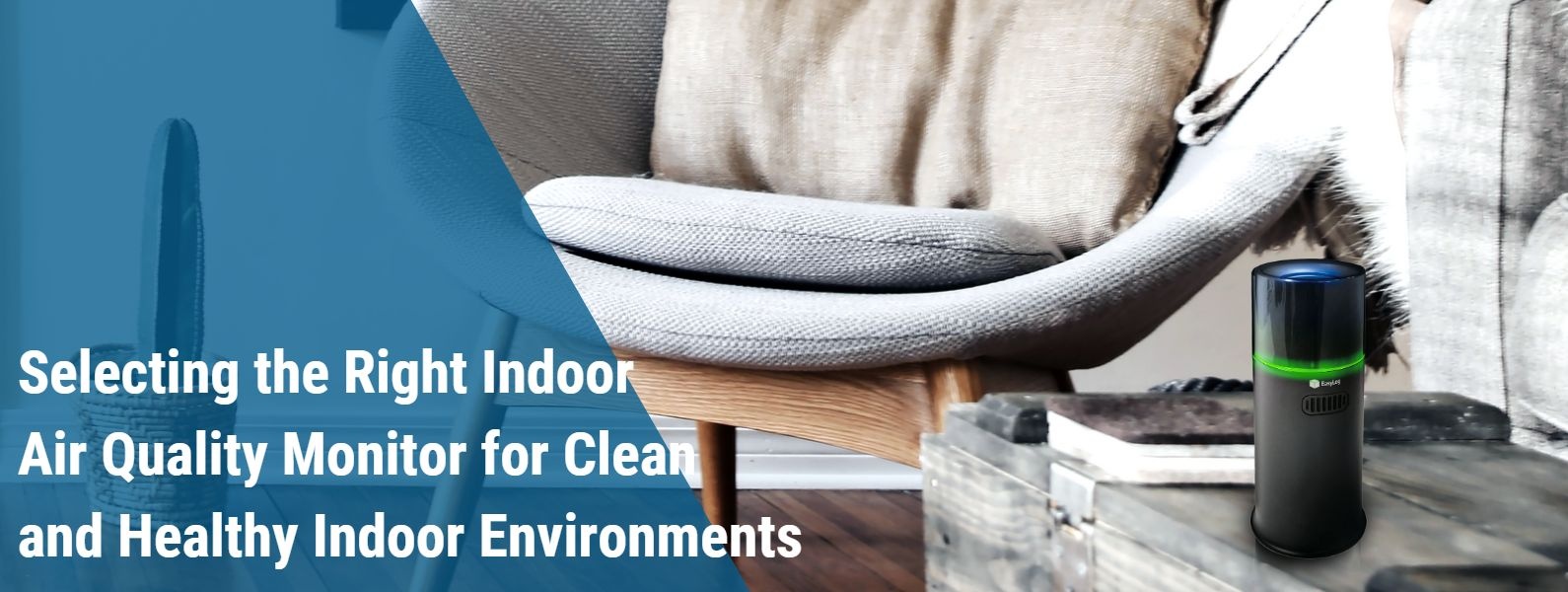Selecting the Right Indoor Air Quality Monitor for Clean and Healthy Indoor Environments
- Posted on
- By Praxas
- Posted in Indoor Air Quality Data Logger, Indoor Air Quality Meter, Indoor Air Quality Monitor
- 0

In today's world, the growing concern over air pollution and its adverse health effects has underscored the importance of collecting accurate and reliable data on Indoor Air Quality (IAQ). An Indoor Air Quality Monitor (also known as an Indoor Air Quality Meter) serves as a valuable tool in assessing pollutant levels such as particle matter, volatile organic compounds (VOCs), carbon dioxide (CO2), and humidity.
By utilising an IAQ monitor, individuals can take proactive steps to enhance air quality and safeguard their health. However, with the plethora of choices available in the market, selecting the most suitable IAQ monitor can be a daunting task.
This comprehensive guide will walk you through the process of choosing the ideal IAQ monitor, highlighting crucial factors such as sensor accuracy, monitoring capabilities, data interpretation, user convenience, and budget considerations. By understanding these critical aspects, you can make an informed decision and actively contribute to maintaining a clean and healthy indoor environment for yourself and those around you.
Understanding Indoor Air Quality Monitors
IAQ monitors are devices designed to measure and evaluate the air quality in indoor environments, including homes, workplaces, schools, and enclosed spaces. Equipped with various sensors, these monitors detect and measure a range of contaminants and factors that impact the air we breathe.
The primary parameters monitored by IAQ sensors include particle matter (PM), VOCs, CO2 levels, humidity, temperature, and occasionally formaldehyde and radon levels. By continually tracking these variables, IAQ monitors provide real-time information about the air quality in a specific area. Armed with this knowledge, users can identify potential air quality problems such as excessive pollution levels or inadequate ventilation and take the necessary steps to address them.
IAQ monitors play a vital role in creating healthier indoor environments by enabling informed decisions regarding ventilation, filtration, and other measures to enhance air quality and occupants' well-being.
The Importance of Testing Indoor Air Quality
Testing indoor air quality is crucial due to its direct impact on human health and well-being. Poor air quality can lead to various health issues, including respiratory diseases, allergies, asthma, and more serious ailments. By monitoring indoor air quality, we can identify potential pollutants and contaminants that may be present. The data obtained from IAQ monitors enables us to take proactive measures to improve air quality, such as adjusting ventilation, installing air purifiers, or addressing specific pollution sources. Additionally, measuring IAQ provides valuable information for regulatory compliance, ensuring that buildings and spaces meet health and safety regulations. Regular testing also helps assess the effectiveness of mitigation techniques and ensures continuous monitoring of air quality for occupant well-being and comfort.
Key Features to Consider in an Air Quality Monitor
When selecting an IAQ monitor, several key features should be considered:
Accurate Sensors
Choosing a monitor with highly accurate sensors is crucial. Accuracy refers to how well the monitor's measurements align with the actual values of the pollutants being monitored. A highly accurate monitor delivers consistent and precise data, enabling users to make informed decisions about improving air quality. It is important to look for monitors that have been tested and calibrated to provide accurate and reliable measurements, instilling confidence in the data received and allowing for effective air quality improvement strategies.
Multiple Parameter Monitoring
Opting for a monitor that can measure and track multiple parameters simultaneously is advantageous. This capability provides a comprehensive evaluation of the indoor environment by providing information on various variables that impact air quality. By monitoring multiple metrics, users can gain a holistic understanding of the air quality and identify potential sources of discomfort or health concerns. For example, tracking PM levels can help monitor airborne particles that may cause respiratory problems while monitoring CO2 levels can reveal the adequacy of ventilation.
Real-Time Data and Alerts
Having access to real-time information and timely alerts is crucial for staying informed about the current air quality conditions. A monitor that offers real-time data enables users to take immediate action if air quality issues arise. Whether it's excessive pollution levels or inadequate ventilation, timely alerts help users address these concerns promptly, ensuring a healthy indoor environment.
Air Quality History and Data Logging
Choose an Indoor Air Quality Data Logger to allow for the collection, storage, and analysis of air quality data over time. By continually collecting measurements of multiple parameters, these monitors generate a historical record of air quality conditions. This historical data can be used to track trends, detect patterns, and evaluate the effectiveness of air quality improvement measures. The ability to produce comprehensive reports summarising the gathered data provides a clear picture of air quality trends and any concerns that need to be addressed. These reports can be shared with experts, building managers, or health authorities for additional analysis or regulatory compliance.
User-Friendly Interface
The interface of an IAQ monitor plays a crucial role in determining how easily users can interact with and comprehend the data. A user-friendly interface provides clear and simple information about the air quality indicators being monitored. It should have straightforward controls and easy navigation, allowing users to access real-time data, adjust settings, and view records with ease. A well-designed interface visually engages users by presenting data in clear graphs, charts, or colour-coded indications, facilitating quick comprehension of the air quality status. An ideal IAQ monitor should include adjustable capabilities that allow users to personalise their monitoring settings and define alarm levels. An intuitive design makes it easier to grasp and analyse data, enabling users to make more informed decisions.
Connectivity and Integration
In the era of smart technology, connectivity and integration features have become essential for IAQ monitors. Many monitors now offer Wi-Fi or Bluetooth connectivity options, allowing users to manage the monitor and access real-time data from their smartphones, tablets, or other connected devices. With wireless connectivity, users can effortlessly monitor air quality from anywhere, receive rapid warnings, and track previous data. Integration with smart home systems further enhances automation and synchronisation with other devices such as air purifiers and thermostats. Additionally, connected monitors often provide advanced capabilities like personalised suggestions, data analysis, and the option to share air quality data with experts or the public. Connectivity improves the user experience, making it more convenient and efficient to monitor and regulate indoor air quality.
Calibration and Maintenance
Calibration is essential to ensure that an IAQ monitor's measurements remain accurate and consistent over time. Regular calibration involves comparing the monitor's results to a reference standard and making any necessary adjustments to maintain accuracy. Maintenance is also necessary to keep the monitor in good working order, involving periodic cleaning, sensor checks, and repairs or replacements as required. Following the manufacturer's maintenance and calibration requirements is crucial for ensuring that the monitor performs reliably and consistently. Regular calibration and maintenance help keep the results accurate, ensuring that the monitor remains a useful tool for measuring and improving indoor air quality.
Cost and Long-Term Value Considerations
When selecting an IAQ monitor, considering the cost and long-term value is essential. While the initial cost of a monitor may vary, it is crucial to assess the monitor's features and capabilities in relation to its price. A higher-priced monitor may offer more precise sensors, better communication options, and additional features that contribute to a more thorough air quality evaluation. However, it is equally important to consider the long-term value of the monitor. A durable and reliable monitor can last for years, minimising the need for frequent replacements. Additionally, a monitor equipped with data logging and historical monitoring capabilities enables trend analysis, informed decision-making, and the implementation of effective methods for maintaining healthy indoor environments. Evaluating the cost and long-term benefits of an IAQ monitor allows users to make an informed decision that aligns with their needs and budget.
Discover the benefits of investing in a Praxas Indoor Air Quality monitor
Selecting the right IAQ monitor is crucial for ensuring a healthy and pleasant indoor environment. Praxas’ air quality monitors encompass essential components, including accurate sensors, multiple parameter monitoring, real-time alerts, data logging, user-friendly interfaces, connectivity options, and calibration. By utilising Praxas’ monitors, users can take control of their indoor air quality, make informed decisions, and create a healthier living or working environment. Harness the power of information and contribute to a healthier atmosphere for yourself and those around you with Praxas’ Indoor Air Quality Monitors.
Download PDF here


Comments
Be the first to comment...